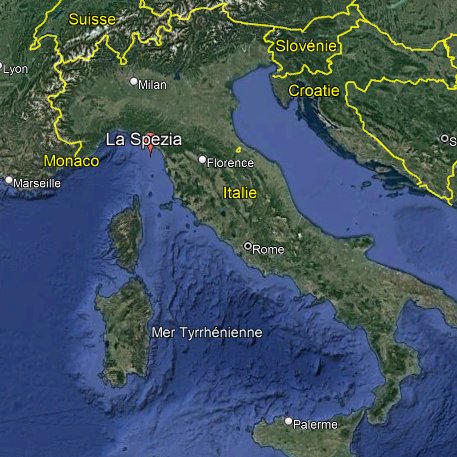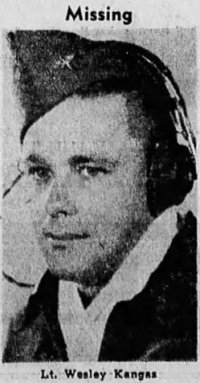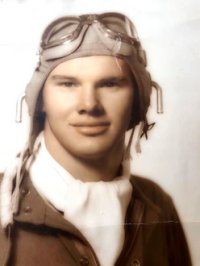ACUFO-1945-02-16-LASPEZIA-1
In the 2000's, ufology sources report a case coming from a military report signed C. S. Miller, and from the 2007 book “Strange Company - Military Encounters with UFOs in World War II”, by Keith Chester, who himself indicated it is documented in the 416th Night Fighter Squadron Daily Operations Report for February 16-17, 1945:
With details I found, it can be said that on that February 16, 1945, at 10:30 p.m., Second Lieutenant Wesley Edward Kangas, pilot, and Second Lieutenant Jack Copeland Herron, radar observer, were flying their De Havilland Mosquito night fighter of the 416th Night Fighter Squadron of the U.S. Army Air Forces on a ground control intercept and patrolling mission along the coast of Italy.
They noticed something flying at around 11,000 feet near La Spezia. Lt. Kangas turned toward the “aircraft” to investigate. It looked to him that “white flares were dropped by what looked like a jet-propelled aircraft.” For the next six minutes the crew chased the unknown aircraft. The crew bore down on the alleged jet, closing in to about one mile, but “it disappeared in a hole of the overcast.”
Lt. Kangas indicated that they were moving at a 380 mph ground speed and Ground Control Intercept (GCI) said that “they had clocked him at 458 mph.” The odd thing surrounding the chase was “there was no radar contact what-so-ever, airborne or otherwise.”
| Date: | February 16, 1945 |
|---|---|
| Time: | Night. |
| Duration: | 6 minutes. |
| First known report date: | February 17, 1945 |
| Reporting delay: | Hours. |
| Country: | Italy |
|---|---|
| State/Department: | Liguria |
| City or place: | La Spezia |
| Number of alleged witnesses: | 2 |
|---|---|
| Number of known witnesses: | ? |
| Number of named witnesses: | 2 |
| Reporting channel: | Military operations report. |
|---|---|
| Visibility conditions: | Night. |
| UFO observed: | Yes. |
| UFO arrival observed: | ? |
| UFO departure observed: | Yes. |
| UFO action: | Drops "flares", goes away. |
| Witnesses action: | Pursuit, in vain. |
| Photographs: | No. |
| Sketch(s) by witness(es): | No. |
| Sketch(es) approved by witness(es): | No. |
| Witness(es) feelings: | ? |
| Witnesses interpretation: | ? |
| Sensors: |
[X] Visual: 2
[ ] Airborne radar: Negative. [ ] Directional ground radar: Negative. [ ] Height finder ground radar: [ ] Photo: [ ] Film/video: [ ] EM Effects: [ ] Failures: [ ] Damages: |
|---|---|
| Hynek: | NL |
| Armed / unarmed: | Armed, 4 7.62 mm Browning machine guns and 4 20 mm Hispano cannons. |
| Reliability 1-3: | 2 |
| Strangeness 1-3: | 2 |
| ACUFO: | Possible extraterrestrial craft. |
[Ref. gvo1:] GODELIEVE VAN OVERMEIRE:
1945, February 16
ITALY, La Spezia coastal region
Mission No. 557 from 10:50 p.m. on the 16th to 1:30 a.m. on 17.2.45. Mosquito Mark XXX night fighter aircraft of the GCI patrol: the pilot sees flashes of light and heads towards them. The shards were released from what appeared to be a jet plane. Hunting on sight, altitude less than 10 miles. Duration of the chase 6 minutes with the pilot getting approximately 1 mile closer to the phenomenon before losing sight of it. The phenomenon disappears in the cloud layer. The pilot indicates a speed in the air of 3800 [sic] MPH, the GCI obtains a speed of 458 MPH on the ground. No echo. Around forty lightning bolts came out of the object at an altitude of around 11,000. (source CPT C. S. Miller, A. C., Warrant Officer. cfr National Archives)
[Ref. dwn2:] DOMINIQUE WEINSTEIN:
At 22h30, the crew of a 416 NFS Black Widow (Lt Kangas and Lt Herron) was on a ground control intercept an patrolling mission along the coast. They noticed something flying at around 11,000 feet near La Spezia. Lt Kangas turned toward the “aircraft” to investigate. It looked to him that “white flares were dropped by what looked like a jet-propelled aircraft.” For the next six minutes the crew chased the unknown aircraft. The crew bore down on the alleged jet, closing in to about one mile, but “it disappeared in a hole of the overcast.” Lt Kangas indicated that they were moving at a 380 mph ground speed and Ground Control Intercept (GCI) said that “they had clocked him at 458 mph.” The odd thing surrounding the chase was “there was no radar contact what-so-ever, airborne or otherwise.”
Sources: 416th NFS Daily Operations Report, 16/17 February, 1945, NARA / Strange Company, Keith Chester, 2007
(Ref. nip1:) "THE NICAP WEBSITE":
Feb. 15/16, 1945; Viareggio, Italy
Alleged jet; multiple spurts of flame; no radar return. (Page 136 Ref.1)
The reference 1 is described at the end of the document as “Strange Company (2007), Keith Chester”.
[Ref. tai1:] "THINK ABOUT IT" WEBSITE:
Date: Feb. 15/16, 1945
Location: Viareggio, Italy
Time:
Summary: Alleged jet; multiple spurts of flame; no radar return.
Source:
The website recorded the case a second time:
Date: Feb. 16, 1945
Location: La Spezia, Italy
Time:
Summary: Possible jet: dropped what looked like white flares; no radar contact.
Source:
The de Havilland DH.98 “Mosquito” was a British multirole aircraft, which served as a fighter-bomber, torpedo bomber and reconnaissance aircraft with the Royal Air Force during the Second World War. The code name for these missions was “Bluestocking”.
Its armament was 4 7.62 mm Browning machine guns and 4 20 mm Hispano cannons.
Its pilot and its navigator were seated side by side, the navigator being shifted back about thirty centimeters for shoulder width.

|

|
The 416th Fighter Squadron of the United States Army Air Forces was equipped with British Beaufighters from 1943 to 1944, and after advanced night fighter training with the Royal Air Force, it deployed to the Mediterranean Theater of Operations. It flew combat missions until Victory Day, earning a Distinguished Unit Citation.
In February 1945, the 416th NFS operated British de Havilland Mosquitos, and it was based at Pomigliano Airfield, Italy, with detachments at Tre Cancello Landing Strip, Italy.
([dwn2] indicated that the aircraft was a P-61 “Black Widow”, which was possible since P-61s had been received by this unit at some time in 1945, but it does not seem correct according to [gvo1] on the one hand, and by the fact that the P-61 normally had a crew of 3 people.)
The American Air Museum Website (www.americanairmuseum.com/archive/unit/416th-fighter-squadron) gives information about the witnesses named in the reports:
Wesley Edward Kangas
Military/Civilian/Mascot: Military
Nationality: American
Unit: 416th Fighter Squadron
Service Numbers: 19148363 / O-767265
Highest Rank: Second Lieutenant
Role/Job: Pilot
Jack Copeland Herron
Military/Civilian/Mascot: Military
Nationality: American
Unit: 416th Fighter Squadron
Service Numbers: O-870849
Highest Rank: Second Lieutenant
Role/Job: Radar Observer
Other historical sources (such as fr.findagrave.com/memorial/179424005/wesley-edward-kangas) report that Second Lieutenant Wesley Edward Kangas was born on April 5, 1922, in Bozeman, Gallatin County, Montana, USA, and died missing in action, as reported in the Press at the time (below), at 23, on April 22, 1945, in Northern Italy.

|
His radar operator Jack Copeland Herron (below), born December 11, 1924 in Chester, Delaware County, Pennsylvania, USA, was killed with him on that mission.

|
Possible extraterrestrial craft.
* = Source is available to me.
? = Source I am told about but could not get so far. Help needed.
| Main author: | Patrick Gross |
|---|---|
| Contributors: | None |
| Reviewers: | None |
| Editor: | Patrick Gross |
| Version: | Create/changed by: | Date: | Description: |
|---|---|---|---|
| 0.1 | Patrick Gross | December 8, 2023 | Creation, [gvo1], [dwn2], [nip1], [tai1]. |
| 1.0 | Patrick Gross | December 8, 2023 | First published. |